One of the first renovations Saunière undertook in his church was the replacement of the old altar. , This new altar he installed and that we can still see in the Eglise Madeleine today was bought from Maison Monna of Toulouse and cost 770FF. The altar was paid for by Madame Cavailhé de Coursan. The old altar was transported to the presbytery. It would later serve in his personal chapel at Villa Bethania after his suspension by Mgr. Beauséjour.
The new altar came with a bas relief of Mary Magdalene in a, grotto with some of the usual props: a skull, a book and a cross. The bas relief was based on a painting by Johann Gerbhard Flatz, a well-known Nazarene and painter of religious scenes in the 19th century. An engraving of this painting was discovered by German researcher Andreas Eckel early 2009 and then linked back to Rennes-le-Château.
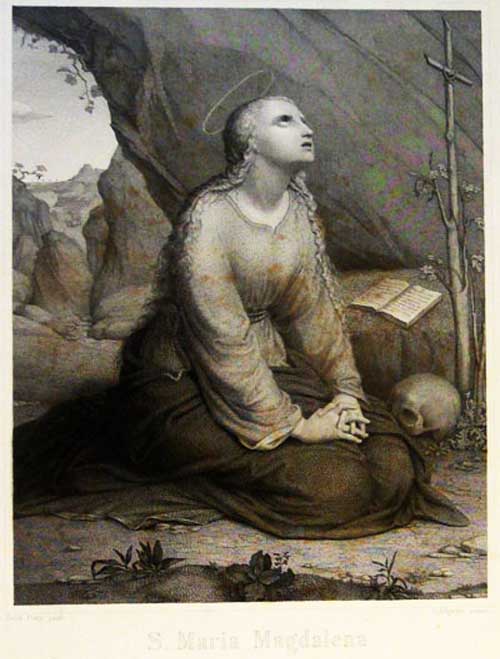
Maria Magdalena, engraving by Julius Allgeyer after a painting by Johann Gebhard Flatz, Karlsruhe 1850. Copyright Andreas Eckel
Until halfway the 1980s, the church of Puichéric had a stained glass window almost identical to the scene on Saunière’s altar as you can see from the photo on the left (copyright André Goudonnet) of that window in 1982.
At the base of the altar Saunière had a phrase inscribed:
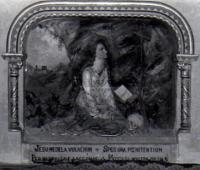
It is bad Latin for Jesus, you remedy against our pains and only hope for our repentance, it is thanks to Magdalene’s tears that you wash our sins away. These same two lines feature at the bottom of what is known as the, Grand Parchment. Today the inscription is no longer there.
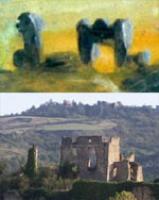
At the left side of the scene, what appears to be two buildings are painted. They don’t feature on the original painting by Flatz. People have concluded they are the Tour Magdala and the Chateâu Hautpoul, but that is far from certain. You might as well say that they are the letters J and M for Jesus and Mary or the ruines of the Château de Coustaussa as is, claimed by others. If they have been indeed been meant to show the, 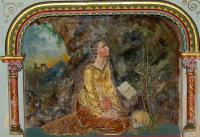
Subject of much discussion has been, the way Mary Magdalene has crossed her fingers in the esoteric symbol of the XXX, indicating that she knows of a great secret (in the masonic meaning of the, 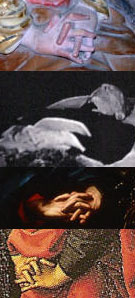
The most bizar anecdote around this theme is without a doubt a story about the death of, Jean Cocteau. The famous French artist was a painter, writer, performer and according to Les Dossiers Secrets alleged Grandmaster of the Priory of Sion. He died an unsuspicious death from a heart attack in 1963. Being a national celebrity, he was placed on the bier and an army of photographers was allowed to shoot him one last time. Jean Brunelin, a well-known French photograper with a great interest in the enigma noticed the peculiar way Cocteau’s fingers were crossed and photographed them. Much to his surprise, when he compared his photos with those of his colleagues shot earlier, he discovered that the hands were folded ‘the normal way’. In other word: someone had purposely forced the deceased’ fingers into this unnatural shape, damaging the corpse. What was so important about the position of a dead man’s fingers that someone violated his deathbed?
The information about Jean Cocteau, in this paragraph is based on an article that appeared in Les Carnets Secrets Magazine, no.5, 2006. More about the Altar and its possible relic is described in this article from 18th January 2008.
If you compare the 1850 German engraving with the bas relief of Mary Magdalene it soons becomes clear that there can be little doubt that either Monna or Saunière used the image or a copy of it as their original. The shape of the grotto, the folded hands, the cross made up of living tree branches, the hair: it is all there. If Saunière added any clues here to the location or nature of what he discovered, it has to be in the text that once stood at the foot of the altar or the J & M buildings on the left.
With the discovery of this engraving, it has become unlikely that the altar bas relief depicts the Grotte du Fournet.
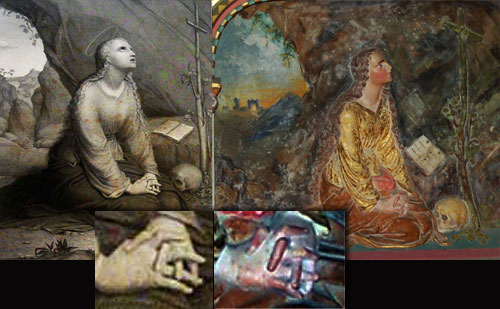
Comparison of Saunière's altar bas relief with Gebhard Flatz' 1850 image of Mary Magdalene, with details of the hands
Another copy in Austria
 In August 2009, Austrian researcher Christof Summer drew the attention to a work of art in the old local church in his hometown of Nofels (Vorarlberg, Austria). In the back of the church, behind the altar with croix patté, a painting of Mary Magdalene occupies the central panel at the top. The church was built in 1726 – 1728 after the community had been split-off from Altenstadt. The funds came from the Mary Magdalene Humlin.
In August 2009, Austrian researcher Christof Summer drew the attention to a work of art in the old local church in his hometown of Nofels (Vorarlberg, Austria). In the back of the church, behind the altar with croix patté, a painting of Mary Magdalene occupies the central panel at the top. The church was built in 1726 – 1728 after the community had been split-off from Altenstadt. The funds came from the Mary Magdalene Humlin.
From the signature at the bottom of the painting it is certain that this concerns a work by local artist Florus Scheel (1864-1936). Apparently this painting, which was produced in 1898, replaced an earlier work of unknown of which we don’t know the subject and artist. It is likely that Scheel, like Julius Allgeyer, copied the original by Johann Gerbhard Flatz. 1898 was allegedly the period that Saunière spent considerable time away from Rennes-le-Château in Lyon.
The relevance of this newly discovered copy lies in the fact that it is executed in full color. The artist who painted Mary Magdalene on Saunière’s altar appears to have stayed very close to the original painting, reproducing Mary’s yellow gown and red mantle.
Allgeyer engraving shown here with kind permission of Andreas Eckel. Jean Cocteau photo copyright Jean Brunelin, shows here with his kind permission. Photos of the panels in the old church of Feldkirch-Nofels by Christof Summer, shown here with his kind permission


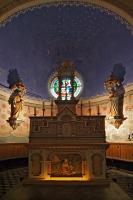
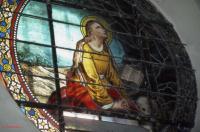
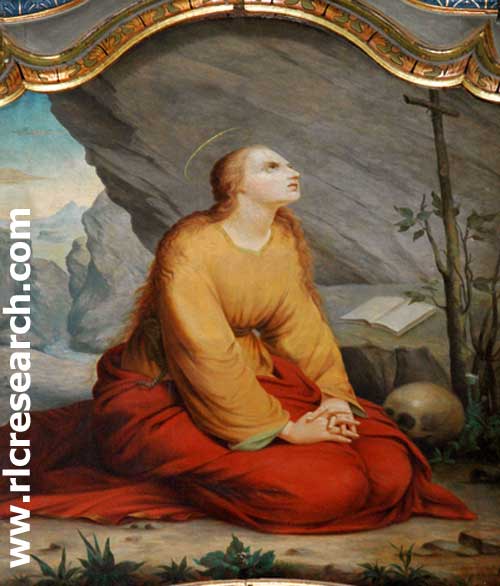

daag, Corjaan!
We guys from the Pommes Bleues Research Group know about that very “Kupferstich” (black and white pic) since December 2007, when Nauty found it in a Swiss Archive.
And “ours” is made by Julius Allgeyer (lived 1829.03.29 – 1900.09.06).
The place in Switzerland is: ThB I, 1907, 315 .
Yours is older, I see. But ours is 100 % the same – and younger.
Just thinking … ;)
What’s happening here?
The altar relief … copoy of a GERMAN drawing.
The bas relief … copy of a GERMAN drawing.
The mines … had GERMAN workers was reported.
In the church … pieces of GERMAN newspapers were found.
The mysterious visitor … supposedly a GERMAN/austrian Erzherzog.
Was Sauniere … actually a GERMAN spy?
For the interlocked fingers of MM:
… pleasehave a look at the 16th century Isenheimer Altar of Grunewald and copy the interlocked fingers of MM there and turn it 90 degrees clockwise and watch.
The buildings are Lincoln Castle and the West Gate of Exchequergate that leads to the West Front of Lincoln Cathedral. The ‘mountain’ is the 1 in 4 gradient of ‘Steep Hill’ upon which the Cathedral is built.
Standing at the ‘x’ marks the spot of Dan Green’s ‘Lincoln Cathedral Code’ you will see all this is correct orientation with Sauniere’s bas-relief.
I think it was the doctor from Espézels that accused Saunière of being a German spy and gold trafficking with Spain…added up with your statements about German works opens up new dimensions here.
Thanks Eginolf! Any more of your findings you want to share..?
Take care | Raven
Hi there,
the swiss guy got the photo from me. It is the same which I provided to raven.
He did not discover anything in any swiss archive..
ask him!
If he claims that his story is true…ask him for more pics…
cheers
DARC
…here you find the complete datasheet regarding the engraving…which I also provided to the swiss guy…
and it seems that he took his advantages of this…but perhaps this is an missunderstanding only…he will tell us ; – )
Plattenkante ca.53 x 36 cm
Stahlstich Karlsruhe um 1850
Genhard Flatz
AKL: Künstlername: Flatz, Gebhard ThB-Name: Flatz, Gebhard Thieme-Becker Dokument Zweitname: Flatz, Gebhardt; Flatz, Johann Gebhard Künstler. Beruf: Maler; Zeichner GEO-Nachweis: Österreich; Italien Staat: Italien; Österreich Geburtsdatum: 1800.06.11 Geburtsort: Wolfurt (Vorarlberg) Todesdatum: 1881.05.19 Todesort: Bregenz Erwähnungsort: Dornbirn (Tirol); Innsbruck; Wien; Rom Fundstelle: AKL XLI, 2004, 102
Künstlername: Allgeyer, Julius AKL Dokument Künstler. Beruf: Kupferstecher GEO-Nachweis: Deutschland Staat: Deutschland Geburtsdatum: 1829.03.29 Geburtsort: Haslach (Kinzigtal) Todesdatum: 1900.09.06 Todesort: München Erwähnungsort: Karlsruhe; Düsseldorf; Rom Erwähnungsland: Schweiz Fundstelle: ThB I, 1907, 315
cu
DARC
DARC
It was not my intention to ask for any discovery instead of you.
Frankly spooken, I don’t know form where this information is coming.
hello
don’t let me be misunderstood …
It was me who THOUGHT that Nauty found the picture but I did not know that he himself got it from Darc. Errare humanum est. Mea culpa et cetera. I’m happy that we know now WHO actually found Allgeyer’s photo: it was Darc.
BTW.
Darc, WHERE did you get it?
and:
Raven, where did YOU get it?
regards
Eginolf
okay … just seen now : Raven got it also from Darc.
… what goes around, comes around … (Dr. John)
… little by little .. (Stevie Ray Vaughan)
Some more:
There is Gebhard Flatz and Julius Allgeyer. But the picture has the name A. Dietrich written.
Now who is who? :))
The picture actually looks like most of ordinary MM scenes … just compare it to the MM in Brügge/Bruges (Coppens wrote a book about Bruges) and you see that this one shows THE SAME as does the MM picture in RLC – only REVERSED. ;))
So I believe: no mystery here … again.
I got the image from DARC and published immediately after his authorization. The scoop is his and it’s a phenomenal discovery.
Thanks Eginolf for getting me in touch with Marion who discovered the Stahlstich that served as the inspiration (or vice versa) for the large Bas Relief Saunière had installed on the west wall of his church (and which is signed A. Dietrich).
I want to express my sincere thanks to everybody participating in this discussion. Thank you for your contributions and trusting me with your materials. It is thanks to you that we can keep this site interesting for longtime and new researchers into this great mystery we share a passion for.
Take care | CJdeR
Hi,
there is an other interisting juicy aspect…
At first glance there are only lines in the book lying beside MM which should symbolse an written text..like on the altar picture in RLC…but I did an high resolution scan of Allgeyers engraving…and discovered that there are real miniature letters in this book…I have asked a specialist for translation of this latin text
Mayby it is an typical bible text only…but maybe there is more…and maybe the reason why Sauniere
has choosen thie picture for his altar?!
I will keep you posted..
cu
DARC
This might already be known to you. This is a small painting of Mary Magdalen in a Connfessional in the church of Our Lady in Bruges. It is in reverse to that of Johann Gerbhard Flatz`z painting, but the fingers are interlaced. I have a photo of the Bruges version.
Hi to all MM researchers,
Just want to say that in our old church we also have a nice MM painting. Which is 99% identic with the image of the Allgeyer engraving on top of this page. But in color. It is signed Florus Scheel 1898(from Feldkirch, Austria), but on fotos I have taken I additionally found “Flatz” under the signature.
An old book tells that this painting (copy)replaced an older and nicer one in 1898. Not clear if the previous one also showed MM. But it possibly the newer reproduction replaced an original. If MM before it might have been a Flatz-Original. The Book furthermore only tells that the previous painting was (then) own by Florus Scheel.
Is this of interest?
Chris from Feldkirch-Nofels, Austria
Gruess dich Chris,
I am VERY interested to see that painting. Would it be possible for you to send me a photo? I will contact you by mail separately.
Thank you for your interest in my website and best regards,
Cj de R
Nice finding.
BTW.
Feldkirch has a castle formally owned by the french Montforts – the family Simon Montfort came from, the head of the albigensian killings in the 13th century.
So there is kind of a connection between Feldkirch and Southern France.
Hi DARC,
Latin texts in books shown in paintings of MM can be very interesting as in this painting of what appears to be MM instructing St. Barnabas:
http://www.aug.edu/augusta/iconography/StaMariaSopraMinerva/maryBarnabas.html
Looking forward to hearing what the specialist has to say!
Whatever the source of Sauniere’s inspiration he used the altar relief to point to Rennes les Bains – in it MM kneels by water, a menhir De la Madelaine is on the River Blanque at Rennes les Bains. The book is Abbe Boudet Langue Celtique … the skull at entrance to cave – Dagobert 11 decapitated ‘and he is there dead’ … a skull and book also used by Sauniere on statue Marie Madelaine. The sapling cross is seen in the Statue of John Baptist with Jesus (St Nazaire), in prayer looking back towards the Holy Water Stoup (Asmodeus). The pool at the bridge in R les B is known as ‘The holy water stoup’ … The Stations of the Cross in St MM trace the path to the church (St Nazaire Et Celse) at Rennes les Bains, where one will find ‘The Treasure of R-le-C’, or Dagobert’s Gold … Poussin’s monogram is on Parchment Two, which doubles to name the Church and Sir William St Clair at Rosslyn confirms it in the ceiling panels to the Chapel.
Geoffrey
if you turn the altar picture upside down then the ruins will show a T W in hebrew numerical value nr 69 the numbers of boas and jachin in latin 23 and 20
Although it is very much grasping at straws to equate the
bas relief in RLC with an austrian, amd possibly
Nazarine style altarpiece,there is an intriguing feature which is a landscape that suggests some local feature which may have been the equivalent sentiment that Sauniere hoped to convey. The name place of the magdalen grotto would certainly have been known to him .As it has already been established that Sauniere had dealings with the austrians wouldn’t such a 19th century practice of sentimentalising through landscape
the known topology of a landscape have appealed to him ,just as it apparently did to the austrian painter commissioned to draw attention to a local landscape?
Another copy of Johann Gebhard Flatz’s (1800-1881, born in Wolfurt-Rickenbach, Austria, active in Rome, Italy) MM found in the internet under http://www.familieforberg.de/index_4_andere_forberg/forberg_maria_magdalena.jpg .
It is a (horizontal flipped) (copper) engraving by Carl Ernst Forberg (1844-1915), art academy Duesseldorf, Germany.
The open book here also has latin letters (like the J. Allgeyer (or A. Dietrich?) engraving from 1850).
And the text below the image shows relation to France.
Furthermore, in an old Vorarlbergian (Western Austrian) newspaper I just found that (at least) 500 approx. 18 inch high steel engraving copies of the Flatz painting were distributed as christmas gifts in December 1868.
Based on all the findings it seems that Flatz’s beautiful MM painting was just much-loved at that time and therefore (with approval of Flatz) copied and distributed many times. Which, of course, further increased the popularity of this “Marie Madeleine en penitence”.
Again, for me the bas-relief painting in RLC appears to be just another (close) copy of the original Flatz painting (which I personally unfortunately have not seen yet).
However, it can not be excluded the Sauniere has deliberately added some hidden hints (for whatever).
As mentioned in my previous post I personally have not seen the original Flatz painting yet.
But, incidentally, in an old local newspaper from 1869 i found a (german) detailed description of a steel engraving copy (probably one of the 500 free exemplars mentioned before). The description says:
– Atoning Mary Magdalene in the cave / grotto Sainte-Baume (close to Marseille).
– In the farest background the Mediterranean Sea and the port town Marseille.
– A little bit closer a desert landscape with probably grazing horses and mules.
– In front of MM the book of books, especially psalm 50, Miserere.
– Below the skull, symbol for Vanitas Vanitatum, material (human) vanity over vanity.
The writer’s name as well as his source are unfortunately not stated. Nevertheless, I would say that he provided some real facts.
In the (low-resolution) images of different Flatz copies shown on this page, including the one of the RLC bas-relief painting, I personnaly cannot see a port town (Marseille). Maybe the copying artist have focussed on the foreground scene and slightly adapted the background to match local views. I also can not read the text in the books.
Anyhow.
I hope this information was helpful for somebody.
Hi Everyone
I am new in all this researches but I can say that everything I read and see at this website is more interesting than materials I read before.
I have found one more difference between relief on Altar of RLC and all the paintings of MM. Don’t know whether it is important or no, but if you look to MM eye view direction on all images of MM at any church or paintings, she looks up. Her eyes are looking upwards. But on relief it is a bit different, she looks more horizontal than upwards, like she is looking for someone standing in front of her.
Just thinking…..